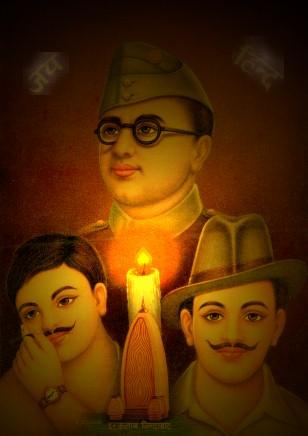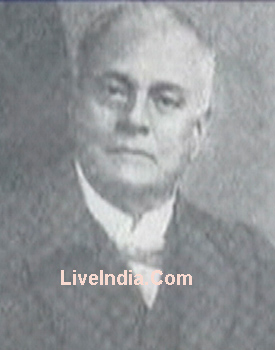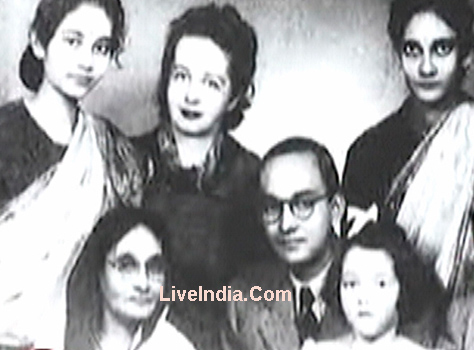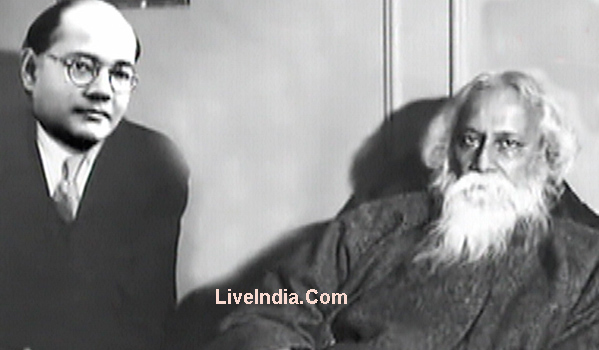 |
 |
| Back to Home |
|
|
 |
 |
 |
| Back to Home |
| Bose
did not die in plane crash: Mukherjee Commission
New Delhi, May 17 The Mukherjee Commission on the alleged disappearance of Netaji Subhas Chandra Bose has inferred that he did not die in a plane crash in 1945 and that the ashes in Renkoji Temple in Japan were not that of Netaji. The Justice M.K. Mukherjee Commission concluded that Bose “is dead”, “he did not die in the plane crash, as alleged”, “the ashes in the Japanese temple are not of Netaji” and that “in the absence of any clinching evidence a positive answer cannot be given” to the terms of reference. The government, which tabled the report in Parliament today, however, rejected the findings of the commission. The views of the government were given in an action taken report (ATR) along with the three-volume report of the commission set up by the previous NDA government in 1999 to inquire into the circumstances concerning the departure of Bose from Bangkok in August 1945, his reported death in an air crash and subsequent developments connected therewith. In its ATR, the government, however, gave no reasons as to why it rejected the report. The ATR, tabled by Minister of State for Home S Regupathy along with the panel’s findings, said the government had examined the commission’s report submitted to it on November 8 last year “in detail and has not agreed with the findings that — Netaji did not die in a plane crash and the ashes in the Renkoji Temple were not of Netaji”.
The
commission said in the absence of any clinching evidence to prove that
‘Bhagwanji-Gumnami Baba was Netaji, the question whether he (Netaji) died
in Faizabad (in Uttar Pradesh) on September 16, 1985, as testified by some
of the witnesses, need not be answered”.
|
|
||||
 |
 Later, the world came to know him as Netaji. After completing his early studies at the European Protestant Collegiate School in Cuttack, he came to Calcutta to study at Presidency College in 1913. Upon completing his graduation, he left India for England to appear at the Indian Civil Service Examination, but he was reluctant to work under the British Government. Thus he resigned and returned to India on the call of Chittaranjan Das. Subhas Chandra Bose felt that young militant groups could be molded into a military arm of the freedom movement and used to further the cause. Gandhiji opposed this ideology because it directly conflicted with his policy of ahimsa (non-violence). The British Government in India perceived Subhas as a potential source of danger and had him arrested without any charge on October 25, 1924. He was sent to Alipore Jail, Calcutta and in January 25, 1925 transferred to Mandalay, Burma. He was released from Mandalay in May, 1927 due to his ill health. Upon return to Calcutta, Subhas was elected President of the Bengal Congress Committee on October 27, 1927. Subhas was one of the few politicians who sought and worked towards Hindu-Muslim unity on the basis of respect of each community's rights. Subhas, being a man of ideals, believed in independence from the social evil of religious discord. In January 1930 Subhas was arrested while leading a procession condemning imprisonment of revolutionaries. He was offered bail on condition that he signs a bond to refrain from all political activities, which he refused. As a result he was sentenced to a year's imprisonment. On his release from jail, Subhas was sworn in as Mayor of the Calcutta Corporation. In 1931 the split between Gandhiji and Subhas crystallized. Although the two never saw eye to eye on their view of freedom and the movement itself, Subhas felt that Gandhiji had done a great disservice to the movement by agreeing to take part in the Second Round Table Conference. Subhas viewed freedom as an absolute necessity, unlike the freedom which Gandhiji was "negotiating" with the British. Subhas was arrested again while returning from Bombay to Calcutta, and imprisoned in several jails outside West Bengal in fear of an uprising. His health once again deteriorated and the medical facilities diagnosed him with tuberculosis. It was recommended that he be sent to Switzerland for treatment. Realizing that his avenues abroad were greater with the restrictions of the British, Subhas set sail for Europe on February 23, 1933. Subhas stayed in various parts of Europe from March 1993 to March 1936 making contacts with Indian revolutionaries and European socialists supporting India's Struggle for Independence. Subhas met Mussolini in Italy and made Vienna his headquarters. Subhas was opposed to the racial theory of Nazism but appreciated its organizational strength and discipline. On March 27, 1936 he sailed for Bombay and but was escorted to jail immediately after disembarking. After lying low for a year, he was able to work actively. He attended the All India Congress Committee Session in Calcutta, the first one he attended after a lapse of nearly six years. Time had healed the tensions between Subhas and Gandhiji, and Gandhiji supported Subhas in his efforts to become the President of the next Congress session, 1938. He went to England for a month in 1938 and rallied for the Indian freedom cause amongst Indian students and British labor leaders sympathetic toward India's cause. It was a bold move since he was constantly under British surveillance. Upon his return to India in February 1938, Subhas was elected President of the Indian National Congress. An excerpt from his Presidential address read, "I have no doubt in my mind that our chief national problems relating to the eradication of poverty, illiteracy and disease and the scientific production and distribution can be tackled only along socialistic lines... ." Subhas emphasized that political freedom alone would not be sufficient, as the ills of the British reign would continue to haunt post-Independent India. He stressed the need to solve linguistic and religious prejudices and to achieve a high literacy rate amongst Indians. Gandhiji found Subhas's ideologies far too leftist and strongly disagreed with Subhas's criticism of village industries and stress on competing with the rest of the world in the Industrial age. Opposition from Sardar Vallabhai Patel, lack of support from Gandhiji and Nehru's indecision marked Subhas's year as the President of the Congress. One of Subhas' major contributions was setting up of a National Planning Committee, for the development of an economic program running parallel to the national movement. Differences between Gandhiji and Subhas led to a crisis when Gandhiji opposed Subhas' idea that the Bengal Government (a coalition between the Krishak Praja Party & Muslim League) be ousted and the Congress take charge in coalition with the Krishak party. The idea was criticized by Gandhiji and Nehru, which resulted in the strengthening of the Muslim League in Bengal and ultimately partition of India. It is obvious today that had Subhas been able to carry out his plans, Bengal would be a different entity on the atlas. Despite opposition from the Congress brass, Subhas was a favorite amongst the majority as he was re-elected for a second term in March 1939. Gandhiji considered Subhas's victory as his personal defeat and went on a fast to rally the members of the Working Committee to resign. Subhas resigned and Dr. Rajendra Prasad assumed the Presidency of the Congress. In May 1939, Subhas formed the Forward Bloc within the Congress as an umbrella organization of the left forces within the Congress. Gandhiji and his supporters accused Subhas of breach of Congress party discipline and drafted a resolution removing Subhas from the Congress Working Committee and restrained him from holding any office for three years. On September 3, 1939 Subhas was informed that war had broken out between Britain and Germany. Subhas discussed the idea of an underground struggle against the British with members of the Forward Bloc. Subhas pressurized the Congress leaders to get a Declaration of War Aims from the Viceroy; he declined. Subhas was elected President of the West Bengal Provincial Congress. In December the Congress Working Committee subverted the Provincial Committee's authority and appointed its own ad hoc committee. The Forward Bloc progressively became militant and by April 1940 most of its senior members were arrested. Subhas was convinced that the only way he could bring about India's Independence was by leaving the country and fighting from foreign territories. He had made contact with radical Punjab and Pathan activists who had contacts in Afghanistan and Russia to organize a militia. Subhas knew that Britain was in a vulnerable position following the surrender of France in June 1940. He announced the launch of Siraj-ud-daula Day on July 3, in memory of the last king of Bengal who was defeated by Clive. His plan was to hold a procession and to unify Hindu and Muslim nationalists. The Government interceded and imprisoned Subhas on July 2, 1940 in Presidency Jail, Calcutta. |
|
Subhash Chandra Bose Live Netaji believed that foreign assistance was a must to free India from British rule. In 1939, when the Second World War broke out, Subhas sought assistance from Germany, Italy, and Japan as they were enemies of Britain and thus would be natural allies. In 1941, he evaded a house-arrest in Calcutta by disguising himself as a Maulavi and going to Kabul, Afghanistan. Later, he procured an Italian passport and fled to Berlin, Germany. There he met Hitler and discussed
his plans and sought his assistance to free India. He also sought assistance
from Mussolini. From time to time, he aired his speeches on the Azad Hind
Radio from Berlin to communicate his intentions to fellow Indians and to
prove that he was still alive. After the defeat of Germany, Netaji realized
that he could not continue his struggle from Germany anymore.
|
|
Netaji wanted unconditional
and complete freedom. He dreamed of a classless society with no caste barriers,
social inequalities or religious intolerance. He believed in equal distribution
of wealth and destruction of communalism. His slogan "Jai Hind" still acts
as a great binding force today
|
| BOSE MYSTERY: AN OVERVIEW
By Anuj Dhar It's amazing how Netaji Subhas Chandra Bose continues to be in news 60 years after his disputed death. In a way, this has been in defiance of successive Indian governments who would rather want the people to sideline him as they have. A recent BBC online poll named Bose the third most popular leader in South Asia after Jinnha and Gandhi. Strikingly, as per the same poll, the stalwarts like Jawaharlal Nehru, Indira Gandhi and the inimitable Atal Bihari Vajpayee don't even blip on the radar anymore. The coming months will see Subhas making a comeback of a sort. India's longest running political controversy is heading towards its grand finale. For five years the media and the lawmakers in India have adopted a touch and go sort of approach towards the inquiry of Justice MK Mukherjee into the "death" of Subhas Bose. Not any longer. The Commission, formed in 1999 following a Court order, is gearing up to present its report by November. The Government will have to present it in Parliament along with an action taken report. All those of you who have interest in either politics, or history, or intrigue, or mystery better watch out: It doesn't get any bigger than this. Psst ...Top Secret! Let this impression be trashed at the outset that the Netaji mystery belongs to a different era. No doubt it started in 1945; but it has been simmering till date. The controversy is a bombshell and that's what the official records hint at. Netaji is supposed to have died at the end of Second World War, and yet the Indian Government continues to sit on files about him. And they are wary of approaching the British and Russian Governments to release the papers they are keeping to themselves. But why so much of precaution over some details about man who ceased to be a problem to his adversaries in and outside India decades back? This is for you Gen-X dudes: Some of the classified Netaji files maintained by the Government of India are of mid-1990s vintage! That is, post-Rajiv Gandhi period. Perish the idea ... "Oh, such an old story, what is the fuss now!" The Government of India wouldn't agree. They think there is something about Netaji that can spell big time trouble even now. That's why they refused to hand over several Top Secret files to the Mukherjee Commission. Why would they be doing so? Well, in the case of two Narasimha Rao period files, they reasoned that the "disclosure of the nature and contents of these documents would ... hurt the sentiments of the people at large and may evoke wide-spread reactions .... Diplomatic relations with friendly countries may also be adversely affected if the said documents are disclosed." Should not we demand to know what these documents have to say? How on earth some bits about a dead man affect India's relations with other countries? Should not we ask our Government to state facts? Don't we have a right to know what happened to the man who liberated us? Pre-conceived notions It's cynicism exemplified when people say, "How long we can go on inquiring?" If Americans, for instance, were to be besotted with same defeatist thinking, they would not have become the great power they are. Indeed they don't give up. How can one leave out in cold those who fight for one's country? Last year only the US Government asked the Indian Government to help them trace out their missing WWII airmen. Netaji went missing while waging war for freedom for us and we don't want to know what happened to him. What is it if not brazen ungratefulness? Those who dismissively say that "there have been commissions after commissions" have no idea whatsoever what sort of frauds were played on the nation by the previous "commissions". In 1956, Shah Nawaz Khan, a Congress MP and a secretary to then Railway Minister, headed a committee -- a puppet on a string, actually. There are reasons to believe that he did what he was told by Nehru government. After his "command performance" Shah Nawaz was made a minister. GD Khosla, who headed a commission in early 1970s, was a friend of Nehru's to start with. He wrote the biography of Prime Minister Indira Gandhi even as he inquired into Netaji's disappearance. Can you imagine such things happening now? Both these panels declared that Netaji had died in a plane crash in Taiwan. Never mind that they did not bother to know what the Taiwan Government thought much as people wanted them to. "But the issue is dead!" Ok, for argument's sake, if that be the case, it is going to COME ALIVE. A Commission of Inquiry headed by a former judge of the Supreme Court of India is going to hand over a report to Home Minister Shivraj Patil, who, at the moment, doesn't seem to be at ease with the direction the Commission is heading to. The report will have to be discussed by the Cabinet before being presented in Parliament for a free for all debate. It is inevitable that Netaji mystery will become a hot topic. Perplexing past Funny how people jump to conclusions. "My grandfather was in the INA and he said Netaji died and therefore I believe so." This is how some give their verdict on the issue the nation is debating for 6 decades. If only it were that easy. There were over 50,000 people aligned with the Provisional Government of Free India and only a handful knew what happened to Netaji in his last known days. The rest were in as much dark as the Indians back home. They all heard stories ... Netaji died or Netaji escaped. The truth, or inkling of it, came out after interrogations and inquiries, whose reports are not in public domain. On August 25, 1945 the Indian newspapers broke the news that Netaji had died in a freak plane crash in Taipei (then Taihoku) on August 18th. He had been flying to Tokyo to work out the INA's surrender when this happened. The British would believe none of it. Viceroy Wavell noted in his diary on 23 August that "I wonder if the Japanese announcement of Subhas Chandra Bose's death in a air-crash is true. I suspect it very much, it is just what should be given out if he meant to go underground..." They dispatched their crack intelligence teams to South East Asia. The findings were bewildering. Netaji was not heading to Tokyo. Months before the world war staggered to a halt, he'd begun planning a new chapter of his war on colonialism. He saw the Cold War coming and reached out to the USSR. The British intelligence got clear information that Subhas was going to Russia at the time of his death. The Japanese had given out a false story about his destination. The survivors of the crash were rounded up and records were captured. The pictured that emerged was of deceit. Eyewitnesses were found to be lying and records appeared as if they had been planted. Americans chipped in with help. In fact it were they who had the best knowledge. They reached Taiwan in September 1945 and guess what they found. " ... there is no direct evidence that Subhas Chandra Bose was killed in a airplane crash … despite the public statements of the Japanese to that effect." This, stated the State Department, ten months after Netaji's "death". What really happened? "The D.I.B. during his recent visit to London mentioned the receipt ... of information to the effect that Subhas Bose was alive in Russia." This is from a May 1946 report and D.I.B. means, the Director of Intelligence Bureau Sir Norman Smith. The Government of free India knew about the Soviet connection to the Netaji mystery. But all they did was to dilly-dally and state that no inquiry was required. It took ten years of pressure before Prime Minister Nehru agreed to inquire into the matter. This must be hammered: the Government never wanted to probe Netaji's fate. From Shah Nawaz to Monoj Mukherjee, each time they were forced to. Isn't it revolting? Present perfect Thank God for Mukherjee Commission! Or shall we thank Mikhail Gorbahev? The fall of the USSR brought the Netaji issue out. In mid-1990s the Russians themselves began saying that Subhas was with them after his death. The matter reached India and the press did rake it up. But Narasimha Rao, with Pranab Mukherjee in tow, would not say a thing. A patriotic fellow moved to Calcutta High Court and the court found the matter to be wide open for inquiry. The Government was chided and told to form a commission of inquiry to find out where and how Netaji had died. Mercifully, at the time the verdict came, the NDA was in power. The inquiry of the Mukherjee Commission in past five years has been pathbreaking. They have found out, among others, that the Government of India, at the PMO level, indulged in systematic, unlawful destruction of evidence concerning the Netaji death case. The Government did not want any inquiry in Taiwan, which is precisely what Justice Mukherjee did. The result: the ROC Government ruled out the very occurrence of the crash that we had been told over decades had killed Netaji. Indian Government also did not want any inquiry in Russia; but that is happening now. After much pulls and pressures, the Mukherjee Commission will visit Russia from September 20 onwards. However, that's not a good enough development. The Government's communication to the Commission suggests that they won't do anything to help the Commission access security and intelligence related classified papers in Russia, said to be containing definite information about Netaji's "post-death" life. Time has come for us, the people of India, to demand from our Government something that they should have done decades back: For God's sake, request the Head of the Russian Government to state facts. The people of India must know what happened to their liberator. source: http://www.missionnetaji.org |
| Back to Home |
 |
 |
|
| Privacy Policy for LiveIndia.Com |
|
|
 |
 |
 |
 |